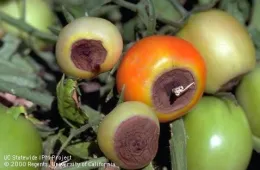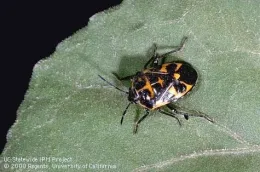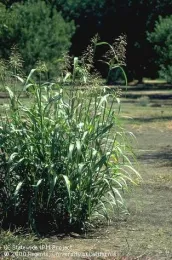Blossom End Rot: Blossom end rot is not a disease but a very common environmental disorder many gardeners see every summer. It affects tomatoes, peppers, and cucurbits. Plants with blossom end rot show small, light brown spots at the blossom end of immature fruit. The affected area gradually expands into a sunken, leathery, brown or black lesion as the fruit ripens. Blossom end rot results from a low level of calcium in the fruit and water balance in the plant. It is aggravated by high soil salt content or low soil moisture and is more common on sandier soils. To reduce rot, monitor soil moisture to make sure that the root zone neither dries out nor remains saturated. Follow recommended rates for fertilizers. Some varieties are more affected than others. The disease is not caused by a pathogen; there are no pesticide solutions. For more information,
click here.
Stink Bugs Two of the most common pests in California gardens are the consperse stink bug and the harlequin bug. Stink bugs attack a variety of fruits and vegetables from stone fruits to pears to beans to tomatoes, often leaving blemishes, depressions, or brown drops of excrement. On green tomatoes, damage appears as dark pinpricks surrounded by a light discolored area that remains green or turns yellow when fruit ripen. To manage these pests, handpick bugs or their eggs. Eliminate groundcovers or weedy areas to prevent population build up. Insecticides are generally not recommended in gardens for stink bugs. Parasites and general predators may contribute to control. For more information,
click here.
Johnsongrass Family: Poaceae Johnsongrass, a coarse and generally clumping grass that can grow to 6 ft tall and has tillers that come from the crown. The seedlings resemble young corn seedlings. It is one of the most troublesome of perennial grasses. It grows best on fertile, moist, well-drained soils where some warm-season moisture is available. Johnsongrass reproduces both by seed and vegetatively from rhizomes. Dormant seed can survive for at least 6 years under prime conditions, and it has been estimated that some seed may remain viable for up to 15 years. Johnsongrass grows rapidly, is highly competitive with other plants, and can be difficult to conttained in early spring when soil is moist and rhizomes are least likely to break. For more information,
click here.






